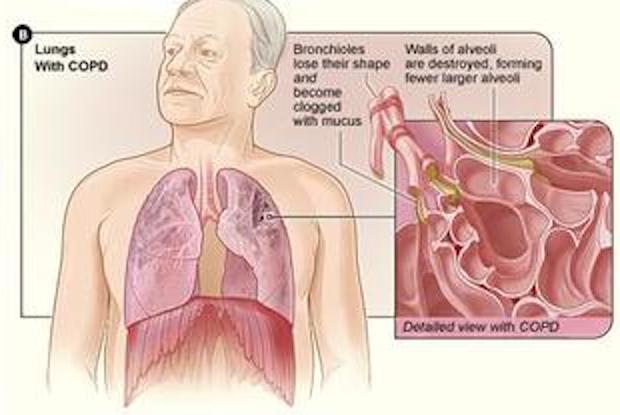Table of Contents
VI. How to support someone with COPD
What is COPD?
Chronic obstructive pulmonary disorder obstructs airflow and inhibits the ability to get oxygen into the lungs. COPD has four stages, 1 being mild and stage 4 severe. If COPD is not well-maintained then the condition can be fatal. It is not possible to reverse the damage of COPD, but there are many ways to improve a patient’s quality of life with the use of medications like Trelegy Ellipta and Flovent.
COPD symptoms most often include:
- Wheezing
- Chronic cough
- Shortness of breath
- Fatigue
- Frequent respiratory infections
More severe symptoms may include:
- Weight loss
- Cardiovascular disease
- Swollen feet and ankles
- Headaches and fever [1]

Life expectancy
There is no single prognosis for COPD patients and many factors play into an individual’s life expectancy. COPD mostly affects elderly people, so there may be several pre-existing health conditions that affect a final prognosis. Two tests are commonly used by doctors to determine the life expectancy of a COPD patient.
GOLD System of Staging
GOLD stands for the Global Initiative for Chronic Obstructive Lung Disease. The GOLD system breaks down COPD into four stages based on a patient’s measured forced expiratory volume (FEV1) percentage. This percentage represents the amount of air a person can expel from their lungs in one second. The GOLD stages rate COPD from 1-4 and people with a higher GOLD grade have a lower life expectancy.
BODE Index
The BODE Index predicts survival in COPD patients. BODE stands for body mass index, airflow obstruction, dyspnea/breathlessness, and exercise capacity. BODE takes into account the FEV1 percentage as well as several other factors. These can include:
The 6 minute walking test: Doctors will have you walk 6 minutes to measure how far a person can walk without experiencing shortness of breath.
Level of breathing difficulty: Doctors will determine how easily you become winded, which will give you a higher score on the BODE scale.
BMI: A person’s body mass index is taken into account to determine exercise capacity. The BMI test considers height, gender, and bone structure.
The BODE index is ranked from 0-10. If you score higher on the scale, then your lung function is not as healthy as it should be. [2]
How to manage your COPD
A doctor will provide the proper medication and treatment plan for each patient. Doctors often prescribe bronchodilators to open up the airways and corticosteroids like Flovent or Trelegy Ellipta to reduce inflammation in the lungs. Your doctor may also recommend supplemental oxygen therapy and maintenance medications to prevent excess mucus buildup.
If your COPD is not properly maintained with the proper medications and therapies, then you may end up hospitalized or on a ventilator. If your COPD continues to worsen, hospice or palliative care may be necessary. Hospice care is for those with late-stage COPD and their condition may soon be fatal. Some late-stage symptoms include:
- Oxygen dependence
- One or more COPD related hospitalizations a year
- Having other health concerns like heart disease, kidney disease, or liver issues
- Weight loss, loss of muscle, and a decreasing ability to perform normal activities

Lifestyle tips
There are many ways to manage your COPD symptoms. It is important to limit your risk factors for COPD, so practicing healthy habits and avoiding harmful substances should be the number one priority. Read below for some helpful tips in staying healthy while maintaining your COPD.
- Get the flu shot every year. You may also want to ask your doctor about the pneumonia and tetanus vaccine, which can help prevent the development of lung infections and whooping cough.
- Take action to stop smoking. Smoke irritates the tissue in the lungs, so it is best to avoid smoking cigarettes or marijuana.
- Take all medication that your doctor prescribes for your condition. Use your inhalers as directed.
- Try your best to avoid second-hand smoke, chemical irritants, and any source of pollution.
- Seek treatment quickly if you notice any signs of a lung infection. Speedy intervention can reduce possible hospitalization.
- Keep a good relationship with your healthcare team. It is important to keep all appointments and maintain open communication with your caregivers. [3]
Helpful exercises
A person with COPD may find pulmonary rehabilitation helpful for their condition. Pulmonary rehabilitation is a program that builds your fitness to help you breathe better. If successful, pulmonary rehab can improve your exercise routines, relaxation, nutrition, as well as provide you emotional support. These strategies for living with COPD can greatly improve your quality of life. Your doctor can refer you to several specialists that can make a pulmonary rehab plan for you.
Exercise may appear impossible if you have a chronic lung disorder, but exercise helps the function of your lungs and heart. These organs need to be exercised just like the rest of your body. Some beneficial exercises can include:
- Arm and chest exercises are important because they help the body in its breathing ability.
- Lower body exercises like walking on a treadmill help increase stamina and test the lung’s ability to withstand cardio exercise.
- Breathing exercises like blowing through a mouthpiece against resistance may increase the strength of your diaphragm and breathing muscles. [4]

How to support someone with COPD
COPD can be a tough and isolating condition, so patients must have proper social outlets and support. Those in the later stages of COPD may require more assistance than those with occasional flare-ups. If you have a friend or family member that could use some help with their condition it can be helpful to:
- Accompany that person to necessary doctor appointments
- Keep a list of their medications and dosages
- Identify symptoms COPD they may not be aware of or notice
Many people who have COPD are older individuals who live alone, so it is vital to provide social support to these patients. Social support can be as simple as sharing a meal with the person or being a helpful companion during everyday activities. [3]
The content provided in this article is based on thorough research and in some cases, reviewed by a medical professional. Our goal for the information is to provide helpful, general health informational. It is not intended as a substitute for professional medical advice.
